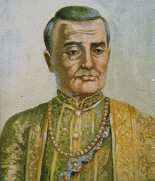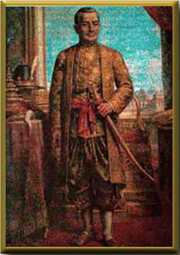
KING BUDDHA YOT FA CHULALOK [ Rama I ] 1782 - 1809
- His Majesty King Phra Buddha Yodfa Chulaloke the first king of the Chakri Dynasty who established
Bangkok as the capital of Thailand. He born in Ayutthaya on March 20, 1737,
the son of Phra Aksorn Sundara Smiantra, he was formerly known as Thong Duang. Following the fall of Ayutthaya in 1767
he entered the service of Phraya Taksin and fought by his side in almost every campaign until the latter became King Taksin, establishing the capital at Thonburi.
He was created Luang Yorkrabat, then Phra Rajvarin, Chao Phraya Chakri and eventually Somdetch Chao Phraya Maha Kashatriya Suk by
King Taksin, and following the deposition of King Taksin on April 6, 1782 [ at the age of 45 ] was chosen King, becoming the founder and first ruler of the House of Chakri two hundred years ago.
- On the year of his accession he moved the capital from Thonburi to the opposite bank
of the Chao Phraya River, thus founding the city of Bangkok. It was
during his reign that the Grand Palace was constructed and he installed the Emerald Buddha in the Chapel
Royal following its completion. He died in Bangkok on September 7, 1809 and, as many historians have
stated, the modern Siam dates from his reign.
- King Rama I or King Ramatibodi reigned for 28 years and passed away in 1809 at the age of 74. On the occasion of the
Rattanakosin Bicentennial 1982, the government decided to give the tillle of "Maharaj" or the Great to King Rama I. He would be called Pra Buddha Yodfa Maharaj.
- King Rama I, whose original name was Duang or Thong Duang was born
in Ayutthaya during the reign of King Barommakote. After
entering monkshood, he joined the King's service as an officer of the royal
household. Later, at the age of 25, he was promoted to be the governor of
Ratchaburi Province and played an important part in helping King Taksin restore
the country's sovereignty many times. He was crowned King at the age of 46
in 1782 and reign for 27 years, dying at the age of 73.
- After his coronation, he decided that Thonburi was unsuitable to
serve as capital because of limited space for expansion of the palace
grounds as both sides were walled in by two temples, namely, the Temple of
Dawn and Wat Tai Talad. Furthermore, the palace being located on the bank
of the Chao Phraya River, was subjected to erosion by the content and
could one day collapse into the river. So, he deemed it appropriate to move
the capital city across to the east bank of the river as the land there was
level with vast space for expansion. Besides, it offered excellent security against enemy attacks.
- King Rama I, after considering the pros and cons from a military
strategic and economic point of view, decided to move the capital to the new
site. He, therefore, erected the city's sacred foundation post as will as
transferred the Lord Buddha's relics to a temporary shrine in a definite
indication as to where the new capital city would be located. After the
foundation post was officially erected, King Rama I moved to the new site and
stayed in a temporary palace made of wood. Soon after, the construction of
the new palace building began and included the Grand Palace, Dusit
Mahaprasat Hall, Pimarnrattaya Hall, Ammarin Vinichchai Hall, and Chakkrabhat
Piman Hall, with residential buildings on both side of the Chakkrabhat Piman Hall.
- King Rama I also built the Wat Phra Kaeo (Temple of the Emerald
Buddha) within the outer compound, east of the Grand Palace. This temple id
the most important one in Thailand since it enshrines the Emerald Buddha image.
- King Rama I also built the fascinating Wat Po and placed 394 old
Buddhist imaged around the main chapel. These images were collected from all parts
of the country and restored to their original condition before being installed in their rightful places.
- He tore down the Vichayen fortress and the wall on the eastern side
of Thonburi in order to make room for the expansion of the city. New canals
too were dug during his reign, such as the Rob Krung canal and the Maha Nakorn canal.
- In ruling the country, King Rama I was very democratic. He would
listen to other people's ideas since he believed that the kingdom did not
belong to him alone. Consequently, the people had their say and helped in running the country.
- When the new capital city was being built, King Rama I was
constantly thinking of the welfare of the people. So after digging canals for the
defense of the country, he ordered the digging of the Mahanak canal
strictly for the people to use as a waterway.
- King Rama I used the same administrative system as that if the Ayutthaya
period but formed a special advisory council by combining viziers, civil
servants and military personnel. These people were hand-picked from among
the top echelon that we must trusted by the king. King Rama I also revised
the law making it suitable to the changing times. In a book called "King
Phra Buddha Yodfa Chulaloke and his Cultural Revivals" written by
HRH Prince Phitayalap Phreuttayakorn, a part reads, "His Majesty the
King was worried about the missing law books, nine out of ten of which
were destroyed or found missing after the Burmese sacked Ayuthaya. In 1804,
King Rama I made a major revision on the laws of the kingdom and came out
with a new one called "Laws of the Three Seals" which consisted of civil and military sides.

Religious Reform
- King Rama I did much in terms of religious reform with the noble aim
to make Buddhism outer for the Rattanakasin era. In 1788, he ordered the
grand council held by Buddhists to revise the Tripitaka as in the previous ones there were many errors.
- King Rama I considered literature of highest importance and which
the country could not do without. He called an assembly learned people and
monks to revive Thai literature and bring it to the level of what it was
during the Ayutthaya period. He joined in and made many contribution despite
the fact that he was engaged in wars against the neighboring countries.
His most outstanding literary work was the epoch Ramayana which was completed
for the first time after the Burmese sacked Ayutthaya. The Ramayana has
really captured the Thai hearts in all respects. No matter where one visits,
one will find Ramayana influence present. His literary works also include
the famous E-Now, Dalunk and Anurat and an epic concerning the war against
the Burmese at Ta Din Daeng.
- King Rama I also promoted the field of architecture, sculpture and
drama. He collected old Buddha images from all over the country and enshrined
them in temples in Bangkok.
- It is recorded in Rattanakosin historical documents that King Rama
I fought in many wars, protecting the country from foreign forces and had
always defeating them. He thus expanded Thai territory farther and wider
than it had been before. It is therefore deemed most appropriate to accord
King Rama I the title "The Great" on the occasion of celebrating
the Bangkok, or Rattanakosin Bicentennial.
|
Top
|
|
Return to the main page
|



